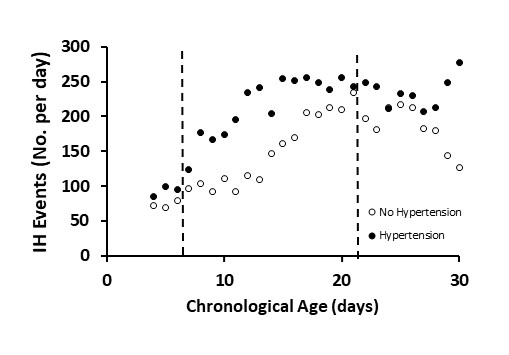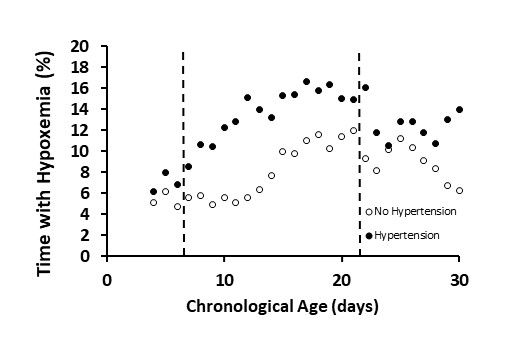Neonatology
Session: Neonatal Nephrology/AKI 1
38 - Intermittent Hypoxemia in Very Preterm Neonates is Associated with Systemic Hypertension at 34-36 weeks Post Menstrual Age
Sunday, May 5, 2024
3:30 PM - 6:00 PM ET
Poster Number: 38
Publication Number: 38.1916
Publication Number: 38.1916
.jpg)
Stephanie C. Martinez, MD (she/her/hers)
Neonatal-Perinatal Medicine Fellow
UH Rainbow Babies & Children's Hospital
Cleveland, Ohio, United States
Presenting Author(s)
Background: Approximately 5% of very premature infants delivered at less than 30 weeks’ gestational age have systemic hypertension (HTN) at some point during their initial hospitalization. In adult and animal data, intermittent hypoxemia (IH) events, such as those caused by obstructive sleep apnea, are associated with HTN. Increased IH events in neonates have been correlated with adverse outcomes and mortality in extremely premature infants.
Objective: We hypothesize that early IH in very preterm neonates is associated with HTN at 34-36 weeks' post menstrual age (PMA).
Design/Methods: This secondary analysis of single center data from the multicenter Pre-Vent study includes 164 infants delivered at less than 31 weeks’ gestational age. IH events were defined as oxygen saturation (SpO2) less than 90% for 10 seconds to 5 minutes with IH frequency and duration assessed during the first 7-21 days of age. Using one recorded blood pressure (BP) per day, HTN was determined if the median BP during 34-36 weeks PMA was greater than the 95th percentile by normative values as defined by Dionne et al 2012 (Dionne et al, Pediatr Nephrol (2012)). Longitudinal plots (Figures 1 and 2) were created to depict IH parameters and HTN. Marginal structural models were applied to evaluate associations between IH parameters and HTN.
Results: Of the included patients, 23% were found to have HTN at 34-36 weeks’ PMA. Infants with more IH events less than 90% SpO2 were more likely to have HTN (OR per 100 events and its 95% CI = 1.26 (1.02-1.55), p=0.033). Infants who spent more time with IH events less than 90% SpO2 were more likely to have higher BPs (Average increase of BP with one percent increase in cumulative percent time less than 90% SpO2 and its 95% CI = 0.0906 (0.0032-0.1779), p=0.042). The 7-21 day window seems to be a key period differentiating patients who did and did not develop HTN (Figures 1 and 2). The following were not significantly associated with HTN at 34-36 weeks’ PMA: umbilical arterial catheters, antenatal steroid exposure, patent ductus arteriosus on echocardiography, and acute kidney injury (defined as serum creatinine greater than 0.5 between 14 days of age and 34 weeks PMA).
Conclusion(s): IH events less than 90% SpO2 at 7-21 days of age are associated with HTN at 34-36 weeks’ PMA, and more time spent with IH less than 90% SpO2 is also associated with higher BPs.
Funding: NIH U01H133643 and U01HL1333708


